Russian threat actors dig in, prepare to seize on war fatigue
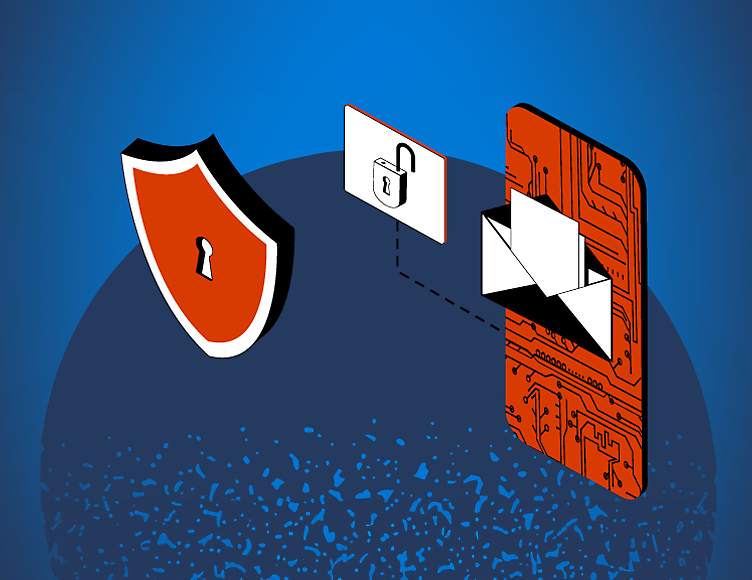
Phases of Russia war in the Ukraine from Jan 2022- June 2023
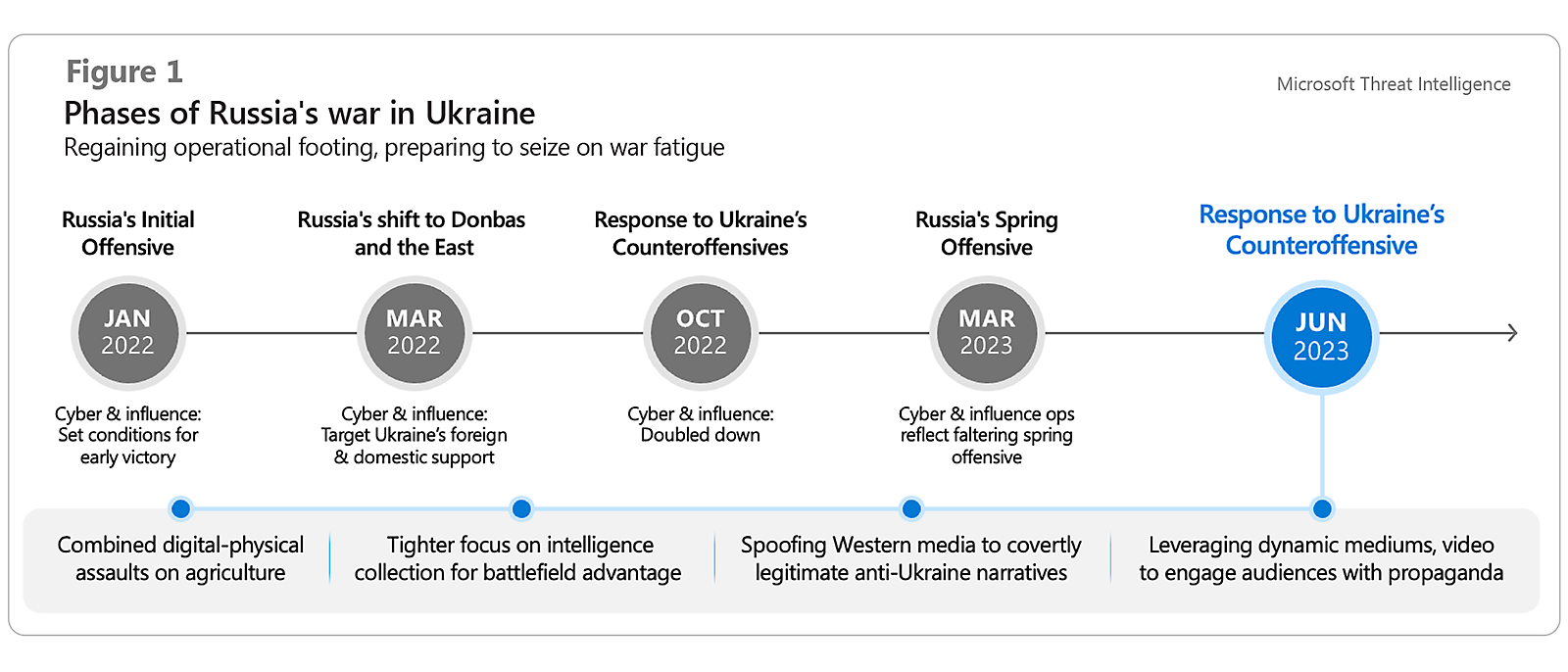
Threat actions Microsoft observed during this March to October period reflected combined operations to demoralize the Ukrainian public and an increased focus on cyber espionage. Russian military, cyber, and propaganda actors directed concerted attacks against the Ukrainian agriculture sector—a civilian infrastructure target—amid a global grain crisis. Cyber threat actors affiliated with Russian military intelligence (GRU) leaned into cyberespionage operations against the Ukrainian military and its foreign supply lines. As the international community sought to punish war crimes, groups linked to Russia’s Foreign Intelligence (SVR) and Federal Security (FSB) services targeted war crimes investigators within and outside of Ukraine.
On the influence front, the brief June 2023 rebellion and later death of Yevgeny Prigozhin, owner of the Wagner Group and infamous Internet Research Agency troll farm, raised questions about the future of Russia’s influence capabilities. Throughout this summer, Microsoft observed widespread operations by organizations that were not connected to Prigozhin, illustrating Russia’s future of malign influence campaigns without him.
Microsoft Threat Intelligence and Incident Response teams have notified and worked with impacted customers and government partners to mitigate the threat activity described in this report.
Russian forces are relying more on conventional weapons to inflict damage in Ukraine, but cyber and influence operations remain an urgent threat to the security of computer networks and civic life within Ukraine’s allies in the region, NATO, and globally. In addition to updating our security products to proactively defend our customers worldwide, we are sharing this information to encourage continued vigilance against threats to the integrity of the global information space.
Russian kinetic, cyber, and propaganda forces converged against Ukraine’s agriculture sector this summer. Military strikes destroyed grain in amounts that could have fed over 1 million people for a year, while pro-Russia media pushed narratives to justify the targeting despite the humanitarian costs.1
From June through September, Microsoft Threat Intelligence observed network penetration, data exfiltration, and even destructive malware deployed against organizations tied to the Ukrainian agricultural industry and grain-related shipping infrastructure. In June and July, Aqua Blizzard (formerly ACTINIUM) stole data from a firm that assists with tracking crop yields. Seashell Blizzard (formerly IRIDIUM) used variants of rudimentary destructive malware Microsoft detects as WalnutWipe/SharpWipe against food/agriculture sector networks.2
Breakdown of Russian digital propaganda activities directed against Ukrainian agriculture
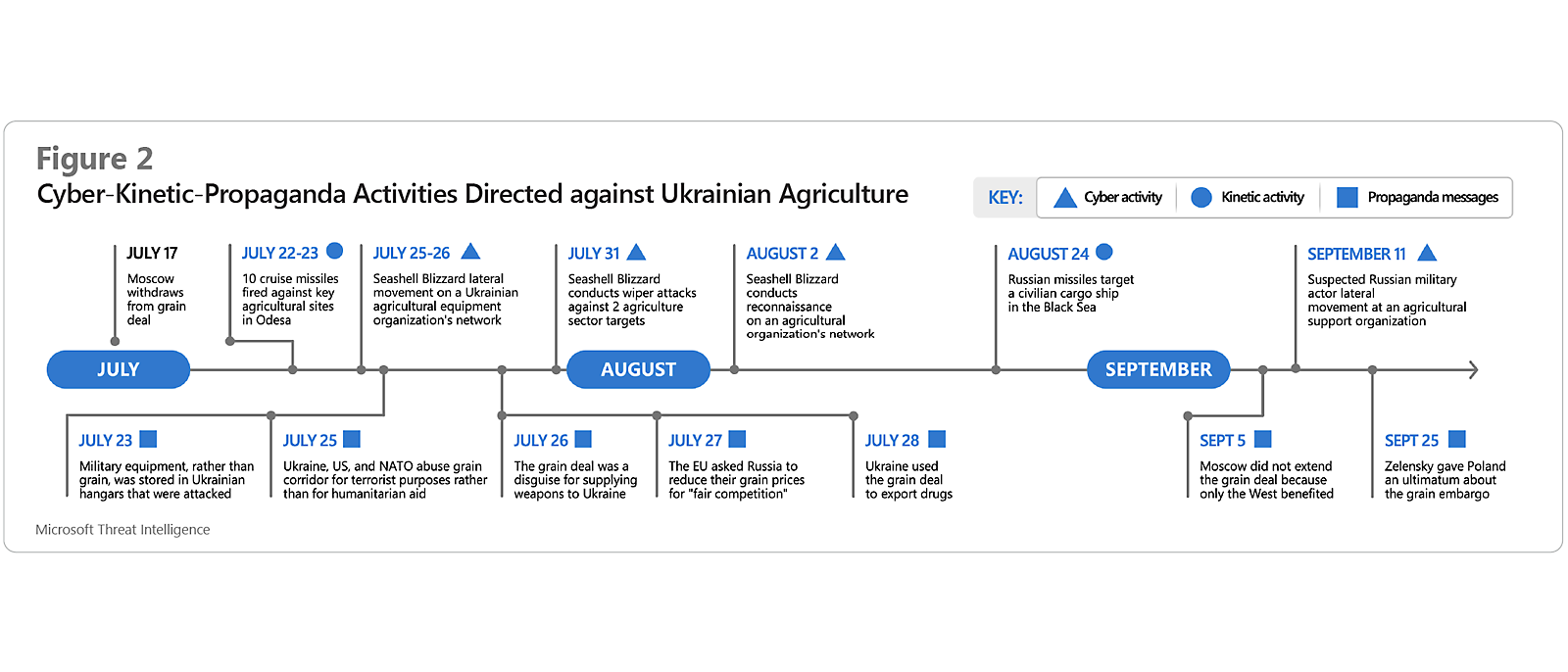
In July, Moscow withdrew from the Black Sea Grain Initiative, a humanitarian effort that helped stave off a global food crisis and allowed for the transport of more than 725,000 tons of wheat to people in Afghanistan, Ethiopia, Kenya, Somalia, and Yemen in its first year.3 After Moscow’s action, Pro-Russia media outlets and Telegram channels jumped in to malign the grain initiative and provide justification for Moscow’s decision. Propaganda outlets painted the grain corridor as a front for drug trafficking or cast it as a means to covertly transfer weapons, to downplay the humanitarian significance of the deal.
In several 2023 reports, we highlighted how legitimate or pseudo hacktivist groups with suspected connections to the GRU have worked to amplify Moscow’s displeasure with adversaries and exaggerate the number of pro-Russia cyber forces.4 5 6 This summer, we also observed hacktivist personas on Telegram spread messages that attempt to justify military assaults on civilian infrastructure in Ukraine and focused distributed denial-of-service (DDoS) attacks against Ukraine’s allies abroad. Microsoft’s continued monitoring of hacktivist groups’ intersection with nation state actors offers additional insights into both entities’ operational tempo and the ways their activities complement each other’s goals.
To date, we have identified three groups—Solntsepek, InfoCentr, and Cyber Army of Russia—that interact with Seashell Blizzard. Seashell Blizzard’s relationship with the hacktivist outlets may be one of short-term use, rather than control, based on the hacktivists’ temporary spikes in cyber capability coinciding with Seashell Blizzard attacks. Periodically, Seashell Blizzard launches a destructive attack that Telegram hacktivist groups publicly claim credit for. The hacktivists then go back to the low-complexity actions they usually conduct including DDoS attacks or leaks of Ukrainian personal information. The network represents agile infrastructure that the APT can use to promote their activity.
Dial of pro-Russian Hacktivism
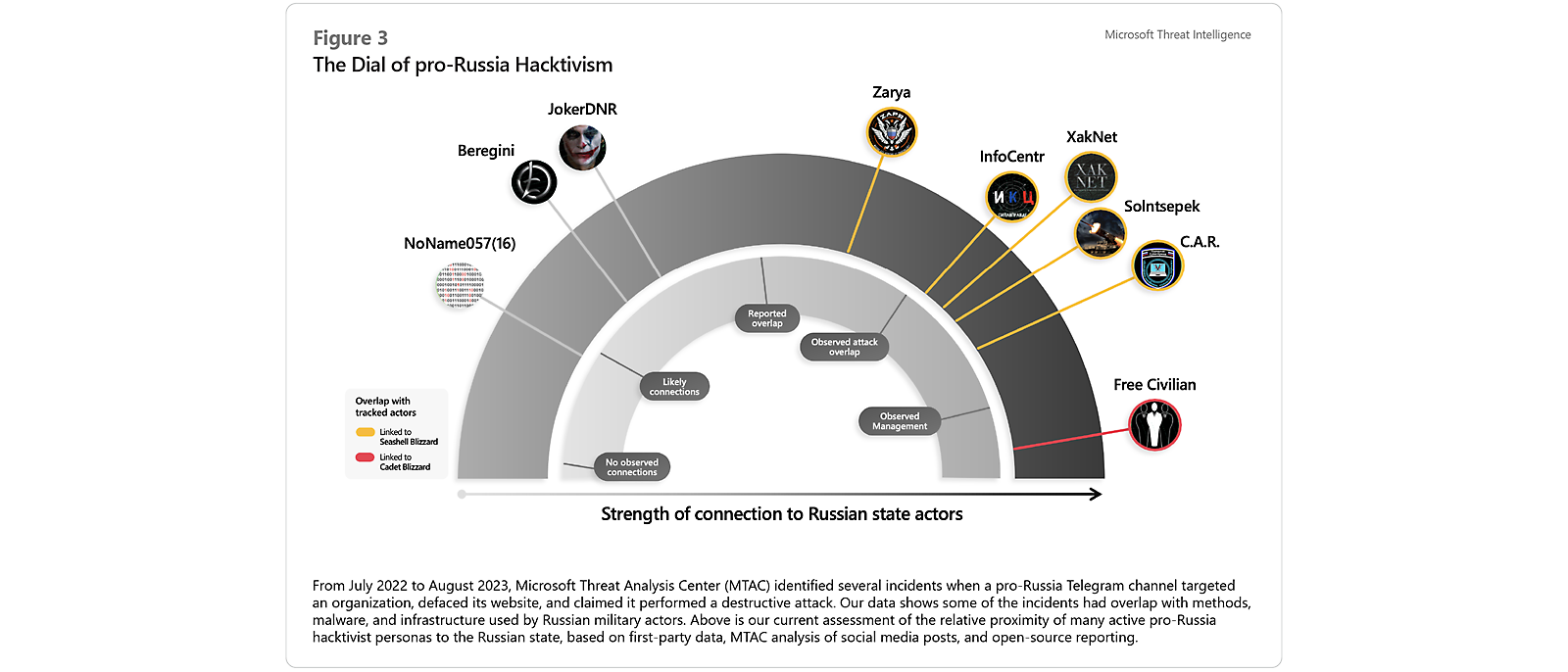
Russian forces are not only engaging in actions that could run afoul of international law, but also targeting the criminal investigators and prosecutors building cases against them.
Microsoft telemetry revealed that actors linked to Russia’s military and foreign intelligence agencies targeted and breached Ukrainian legal and investigative networks, and those of international organizations involved in war crimes investigations, throughout the spring and summer this year.
These cyber operations occurred amid mounting tensions between Moscow and groups like the International Criminal Court (ICC), which issued an arrest warrant for Russian President Putin on war crimes charges in March.7
In April, GRU-linked Seashell Blizzard compromised the network of a law firm that focuses on war crimes cases. Aqua Blizzard, attributed to the FSB, breached the internal network of a major investigative body in Ukraine in July, then used compromised accounts there to send phishing emails to several Ukrainian telecom firms in September.
SVR actors Midnight Blizzard (formerly NOBELIUM) compromised and accessed the documents of a legal organization with global responsibilities in June and July before Microsoft Incident Response intervened to remediate the intrusion. This activity was part of a more aggressive push by this actor to breach diplomatic, defense, public policy, and IT sector organizations worldwide.
A review of Microsoft security notifications issued to impacted customers since March revealed that Midnight Blizzard has pursued access to more than 240 organizations predominantly in the US, Canada, and other European countries, with varying degrees of success.8
Russian threat actors used various techniques to gain initial access and establish persistence on targeted networks. Midnight Blizzard took a kitchen sink approach, using password spray, credentials acquired from third parties, believable social engineering campaigns via Teams, and abuse of cloud services to infiltrate cloud environments.9 Aqua Blizzard successfully integrated HTML smuggling in initial access phishing campaigns to reduce the likelihood of detection by anti-virus signatures and email security controls.
Seashell Blizzard exploited perimeter server systems such as Exchange and Tomcat servers and simultaneously leveraged pirated Microsoft Office software harboring the DarkCrystalRAT backdoor to gain initial access. The backdoor allowed the actor to load a second stage payload we call Shadowlink, a software package masquerading as Microsoft Defender that installs the TOR service on a device and gives the threat actor surreptitious access via the TOR network.10
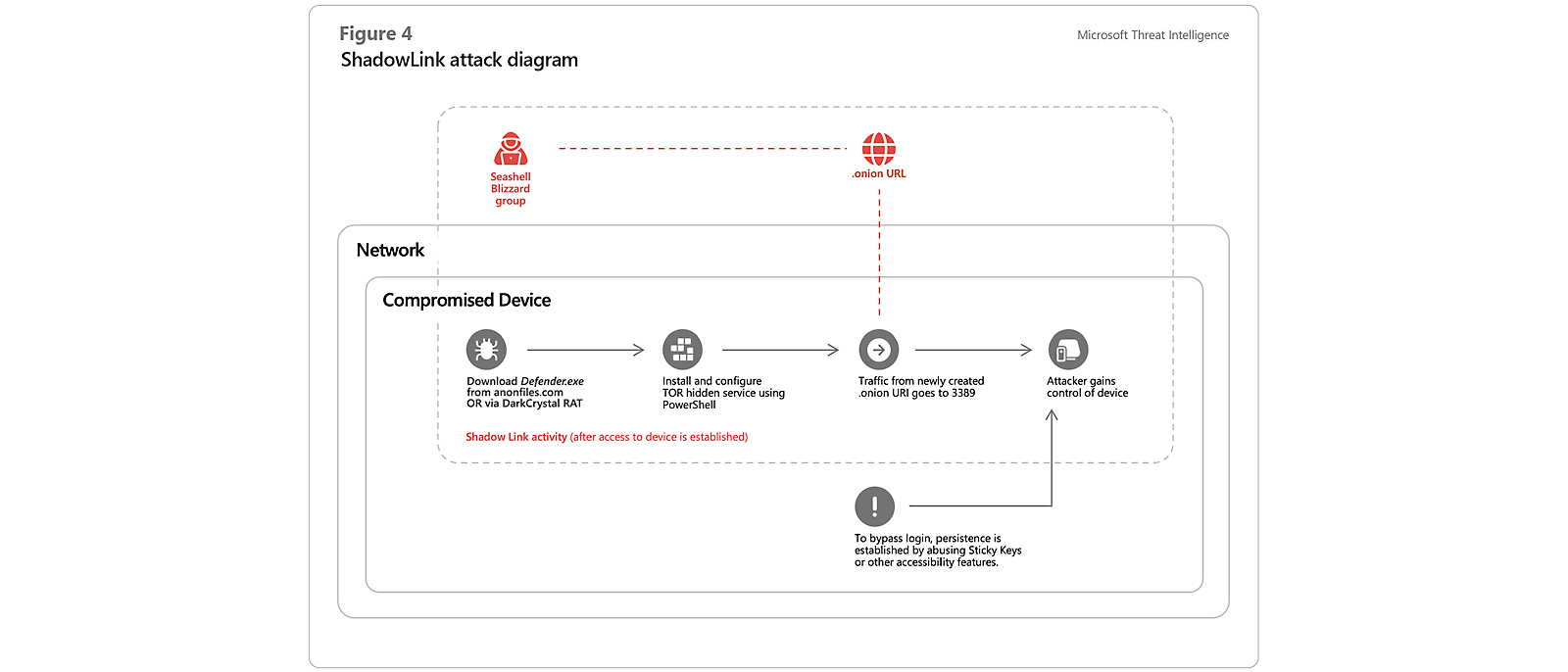
Since Russian forces launched their spring 2023 offensive, GRU- and FSB-affiliated cyber actors have concentrated their efforts on intelligence collection from Ukrainian communications and military infrastructure in combat zones.
As of March, Microsoft Threat Intelligence connected Seashell Blizzard to potential phishing lures and packages that appeared tailored to target a major component of Ukrainian military communications infrastructure. We had no visibility on follow-on action. According to the Ukrainian Security Service (SBU), Seashell Blizzard’s other attempts to access Ukrainian military networks included malware that would allow them to collect information about the configurations of connected Starlink satellite terminals and glean the location of Ukrainian military units.11 12 13
Secret Blizzard (formerly KRYPTON) also moved to secure intelligence collection footholds in Ukrainian defense-related networks. In partnership with the Government Computer Emergency Response Team of Ukraine (CERT-UA), Microsoft Threat Intelligence identified the presence of Secret Blizzard’s DeliveryCheck and Kazuar backdoor malware on Ukrainian defense forces’ systems.14 Kazuar allows more than 40 functions including stealing credentials from a variety of applications, authentication data, proxies, and cookies, and data retrieval from operating system logs.15 Secret Blizzard was particularly interested in stealing files with messages from the Signal Desktop messaging application, which would allow them to read private Signal chats.16
Forest Blizzard (formerly STRONTIUM) renewed focus on its traditional espionage targets, defense-related organizations in the United States, Canada, and Europe, whose military support and training are keeping Ukrainian forces equipped to continue the fight.
Since March, Forest Blizzard has attempted to gain initial access to defense organizations via phishing messages that incorporated novel and evasive techniques. For example, in August, Forest Blizzard sent a phishing email that incorporated an exploit for CVE-2023-38831 to accountholders at a European defense organization. CVE-2023-38831 is a security vulnerability in WinRAR software that allows attackers to execute arbitrary code when a user attempts to view a benign file within a ZIP archive.
The actor is also leveraging legitimate developer tools such as Mockbin and Mocky for command and control. As of late September, the actor conducted a phishing campaign abusing GitHub and Mockbin services. CERT-UA and other cybersecurity firms publicized the activity in September, noting the actor used adult entertainment pages to entice victims to click a link or open a file that would redirect them to malicious Mockbin infrastructure.17 18 Microsoft observed a pivot to using a technology-themed page in late September. In each case, the actors sent a phishing email containing a malicious link that would redirect the victim to a Mockbin URL and download a zip file bundled with a malicious LNK (shortcut) file masquerading as a Windows update. The LNK file would then download and execute another PowerShell script to establish persistence and conduct follow-on actions like data theft.
Example screenshot of PDF lure associated with Forest Blizzard phish of defense organizations.
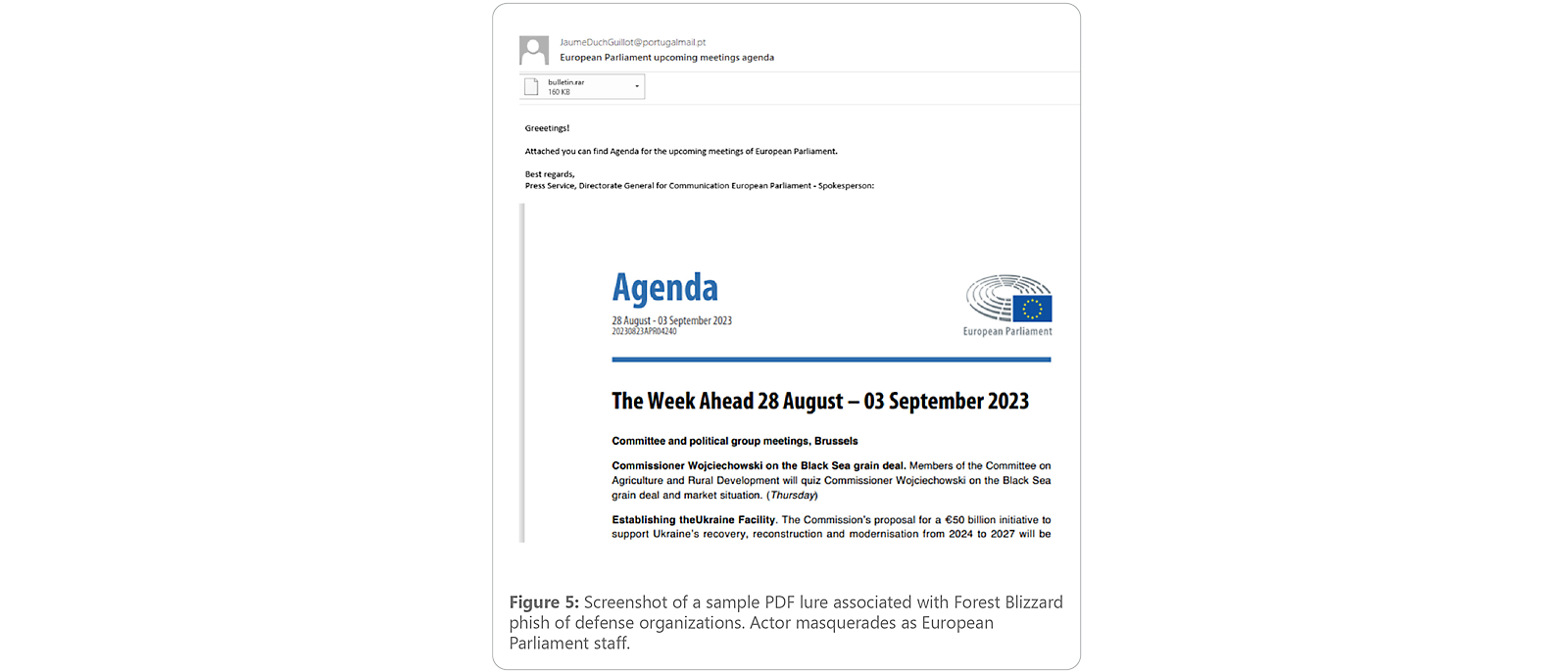
Throughout 2023, MTAC continued observation of Storm-1099, a Russia-affiliated influence actor responsible for a sophisticated pro-Russia influence operation targeting international supporters of Ukraine since the spring of 2022.
Perhaps best known for the mass-scale website forgery operation dubbed “Doppelganger” by research group EU DisinfoLab,19 Storm-1099’s activities also include unique branded outlets such as Reliable Recent News (RRN), multimedia projects such as anti-Ukrainian cartoon series “Ukraine Inc.,” and on-the-ground demonstrations bridging the digital and physical worlds. Although attribution is incomplete, well-funded Russian political technologists, propagandists, and PR specialists with demonstrable ties back to the Russian state have conducted and supported several Storm-1099 campaigns.20
Storm-1099’s Doppelganger operation remains in full force as of the time of this report, despite persistent attempts by technology companies and research entities to report on and mitigate its reach.21 While this actor has historically targeted western Europe—overwhelmingly Germany—it has also targeted France, Italy, and Ukraine. In recent months Storm-1099 has shifted its locational focus towards the United States and Israel. This transition began as far back as January 2023, amid large-scale protests in Israel against proposed judicial overhaul and intensified after the onset of the Israel-Hamas war in early October. Newly created branded outlets reflect an increasing prioritization of US politics and the upcoming 2024 US presidential elections, while existing Storm-1099 assets have forcefully pushed the false claim that Hamas acquired Ukrainian weapons on the black market for its October 7 attacks in Israel.
Most recently, in late October, MTAC observed accounts Microsoft assesses to be Storm-1099 assets promoting a new kind of forgery in addition to fake articles and websites on social media. These are a series of short fake news clips, ostensibly created by reputable outlets, which spread pro-Russia propaganda to undermine support for both Ukraine and Israel. While this tactic—using video spoofs to push propaganda lines—is a tactic observed in recent months by pro-Russia actors more broadly, Storm-1099’s promotion of such video content only highlights the actor’s varied influence techniques and messaging goals.
Articles published on fake Doppelganger sites
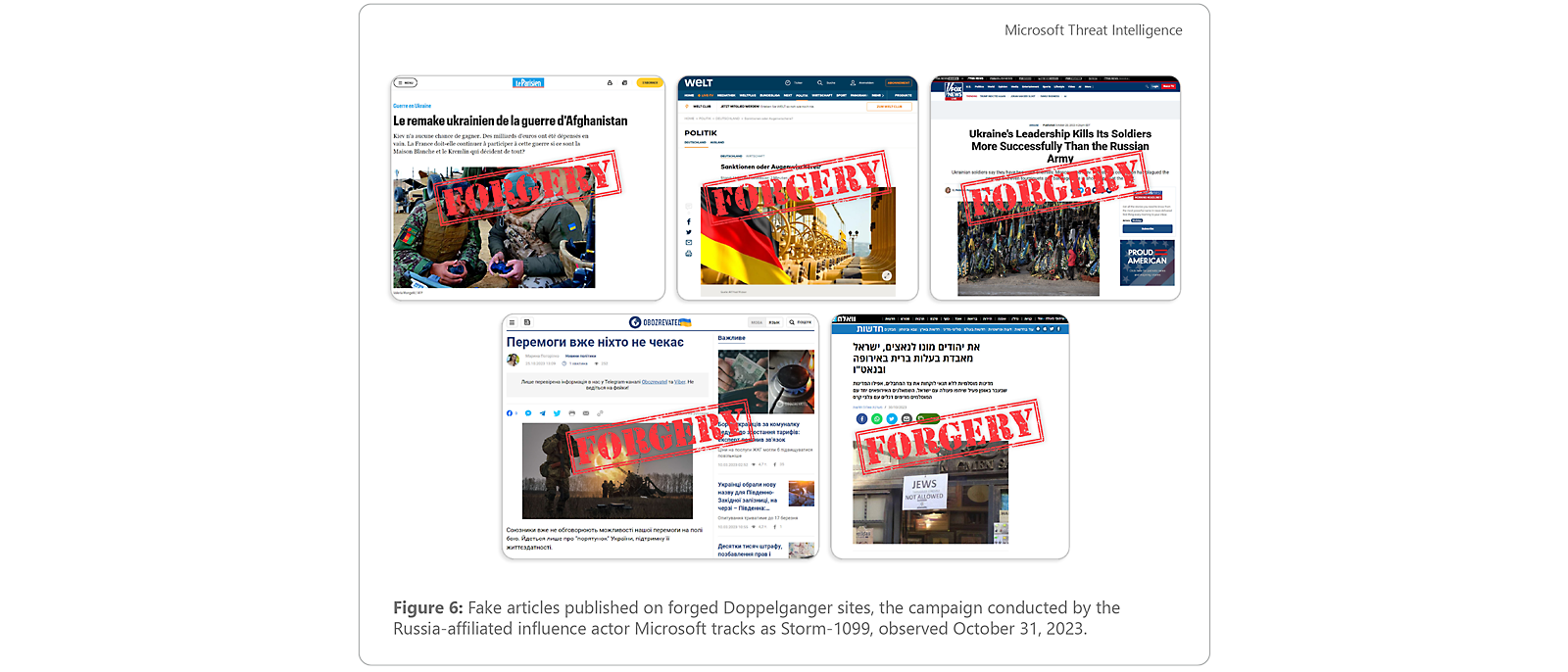
Since Hamas’s attacks in Israel on October 7, Russian state media and state-aligned influence actors have sought to exploit the Israel-Hamas war to promote anti-Ukraine narratives, anti-US sentiment, and exacerbate tension among all parties. This activity, while reactive to the war and generally limited in scope, includes both overt state-sponsored media and covert Russia-affiliated social media networks spanning multiple social media platforms.
Narratives promoted by Russian propagandists and pro-Russian social media networks seek to pit Israel against Ukraine and diminish Western support for Kyiv by falsely claiming that Ukraine armed Hamas militants in spoofs of reputable media outlets and manipulated videos. An inauthentic video that claimed foreign recruits, including Americans, were transferred from Ukraine to join Israeli Defense Forces (IDF) operations on the Gaza Strip, which garnered hundreds of thousands of views across social media platforms, offers just one example of such content. This strategy both propels anti-Ukrainian narratives to a wide audience and drives engagement by shaping false narratives to align with major developing news stories.
Russia also augments digital influence activity with promotion of real-world events. Russian outlets have aggressively promoted incendiary content amplifying protests related to the Israel-Hamas war in the Middle East and Europe—including via on-the-ground correspondents from Russian state news agencies. In late October 2023, French authorities alleged four Moldovan nationals were likely linked to stenciled Star of David graffiti in public spaces in Paris. Two of the Moldovans reportedly claimed that they were directed by a Russian-speaking individual, suggesting possible Russian responsibility for the graffiti. Images of the graffiti were later amplified by Storm-1099 assets.22
Russia likely assesses that the ongoing Israel-Hamas conflict is in its geopolitical advantage, as it believes the conflict distracts the West from the war in Ukraine. Following oft-used tactics in Russia’s established influence playbook, MTAC assesses such actors will continue seeding online propaganda and leveraging other major international events to provoke tension and attempt to encumber the West’s ability to counteract Russia’s invasion of Ukraine.
Anti-Ukraine propaganda has broadly permeated Russian influence activity since before the 2022 full-scale invasion. In recent months, however, pro-Russia and Russia-affiliated influence networks have focused on using video as a more dynamic medium to spread these messages coupled with spoofing authoritative media outlets to leverage their credibility. MTAC has observed two ongoing campaigns conducted by unknown, pro-Russia actors that involve spoofing mainstream news and entertainment media brands to push manipulated video content. Like previous Russian propaganda campaigns, this activity focuses on painting Ukrainian President Volodymyr Zelensky as a corrupt drug addict and Western support for Kyiv as detrimental to those countries’ domestic populations. The content in both campaigns consistently seeks to diminish support for Ukraine but adapts narratives to align with emerging news events—like the June 2023 Titan submersible implosion or the Israel-Hamas war to reach wider audiences.
Diagram showing spoofed news clips overview
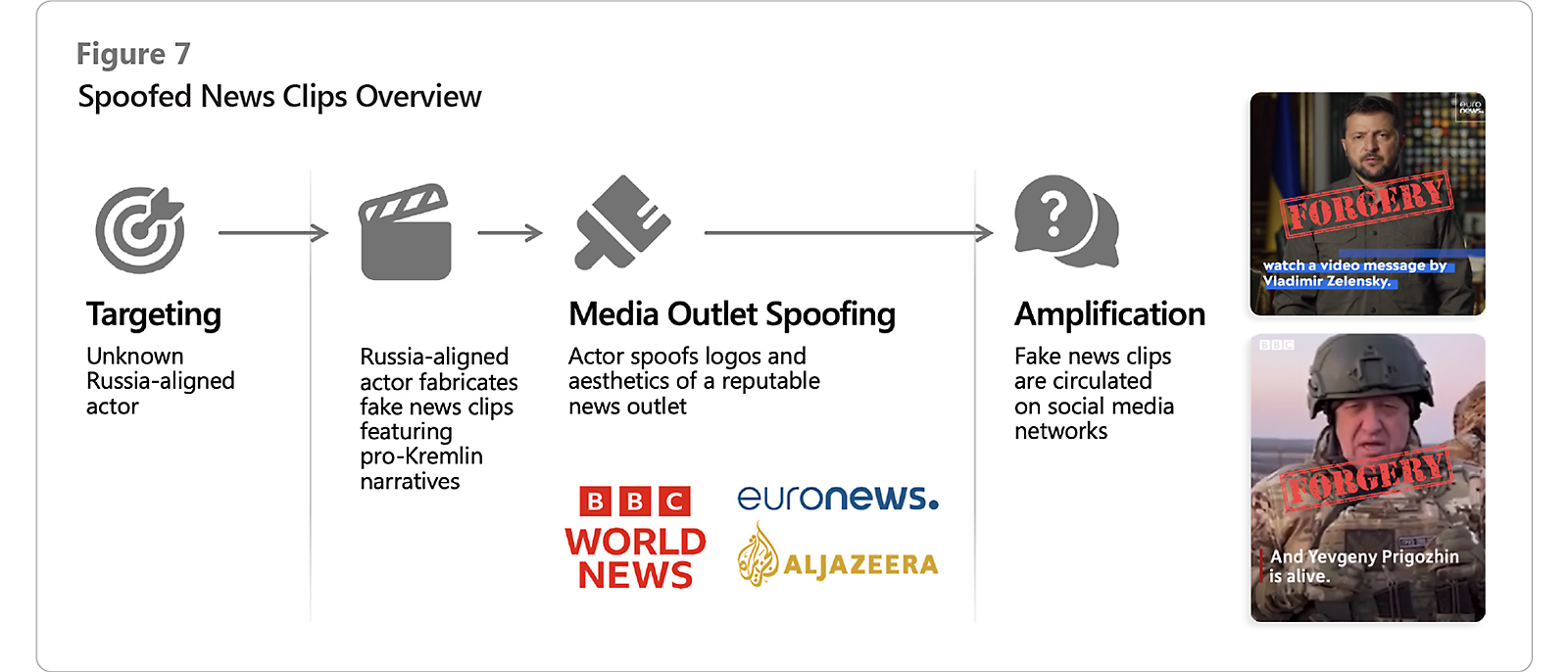
One of these video-centric campaigns involves a series of fabricated videos that spread false, anti-Ukrainian, Kremlin-affiliated themes, and narratives under the guise of short news reports from mainstream media outlets. MTAC first observed this activity in April 2022 when pro-Russia Telegram channels posted a fake BBC News video, which claimed that the Ukrainian military was responsible for a missile strike that killed dozens of civilians. The video uses BBC’s logo, color scheme and aesthetics, and features English-language captions containing errors commonly made when translating from Slavic languages to English.
This campaign continued throughout 2022 and accelerated in the summer of 2023. At the time of compiling this report, MTAC has observed more than a dozen spoofed media videos in the campaign, with the most frequently spoofed outlets being BBC News, Al Jazeera, and EuroNews. Russian-language Telegram channels first amplified the videos before they spread to mainstream social media platforms
Screen shots of videos imitating the logo and aesthetics of BBC news (left) and EuroNews (right)
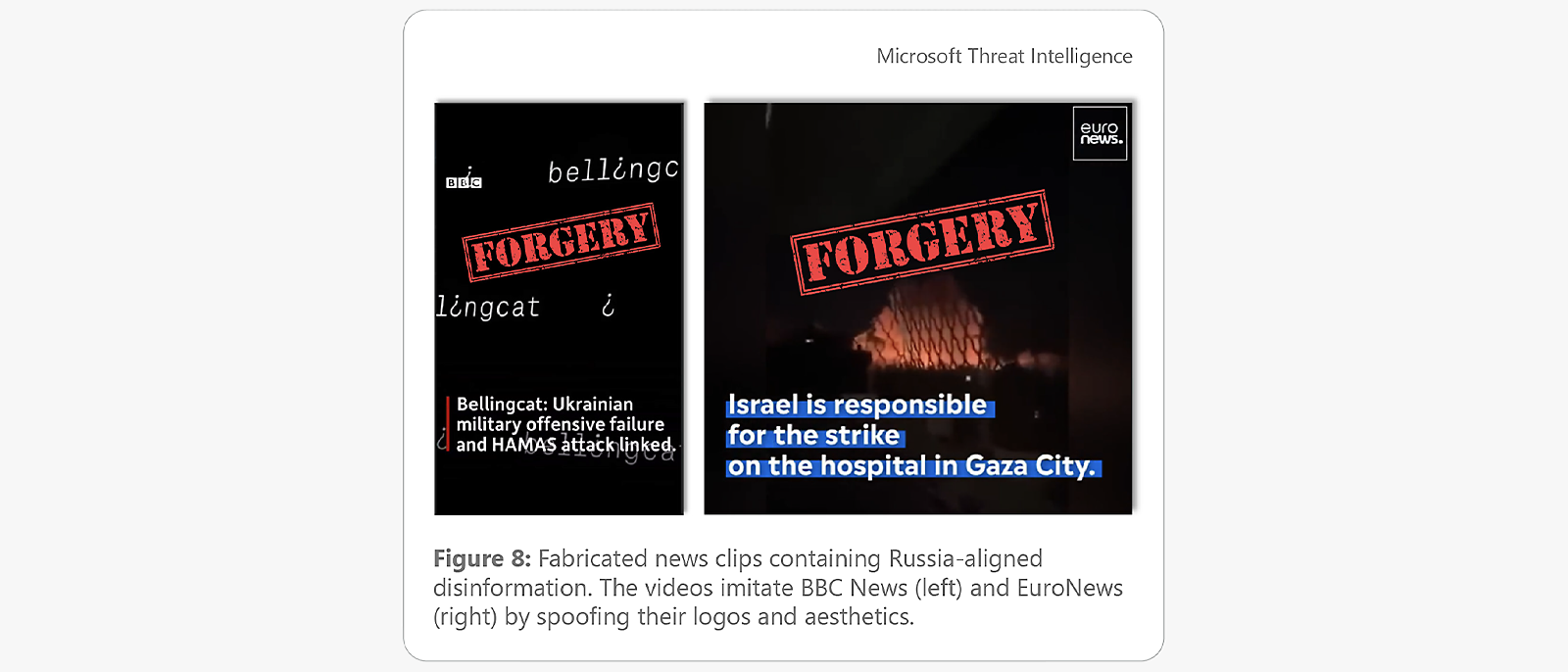
Although this content has had limited reach, it could pose a credible threat to future targets if refined or improved with the power of AI or amplified by a more credible messenger. The pro-Russia actor responsible for the spoofed news clips is sensitive to current world events and nimble. For example, a spoofed BBC News video falsely claimed that investigative journalism organization Bellingcat uncovered that weapons used by the Hamas militants were sold to the group by Ukrainian military officials through the black market. This video content closely mirrored public statements made by former Russian President Dmitry Medvedev just one day before the video was released, demonstrating the campaign’s strong alignment with overt Russian government messaging.23
Starting in July 2023, pro-Russia social media channels began circulating videos of celebrities, deceptively edited to push anti-Ukraine propaganda. The videos—the work of an unknown Russia-aligned influence actor—appear to leverage Cameo, a popular website where celebrities and other public figures can record and send personalized video messages to users who pay a fee. The short video messages, which often feature celebrities pleading with “Vladimir” to seek help for substance abuse, are edited by the unknown actor to include emojis and links. Videos circulate through pro-Russian social media communities and are amplified by Russian state-affiliated and state-run media outlets, falsely portrayed as messages to Ukrainian President Volodymyr Zelensky. In some cases, the actor added media outlet logos and social media handles of celebrities to make the video look like news clips from reporting on the celebrities’ supposed public appeals to Zelensky or the celebrities’ own social media posts. Kremlin officials and Russian state-sponsored propaganda have long promoted the false claim that President Zelensky struggles with substance abuse; however, this campaign marks a novel approach by pro-Russia actors seeking to further the narrative in the online information space.
The first video in the campaign, observed in late July, features Ukrainian flag emojis, watermarks from American media outlet TMZ, and links to both a substance abuse recovery center and one of President Zelensky’s official social media pages. As of late October 2023, pro-Russia social media channels have circulated six more videos. Notably, on August 17, Russian state-owned news outlet RIA Novosti published an article covering a video featuring American actor John McGinley, as if it were an authentic appeal from McGinley to Zelensky.24 Beyond McGinley, celebrities whose content appears in the campaign include actors Elijah Wood, Dean Norris, Kate Flannery and Priscilla Presley; musician Shavo Odadjian; and boxer Mike Tyson. Other state-affiliated Russian media outlets, including US-sanctioned media outlet Tsargrad, have also amplified the campaign’s content.25
Still images from videos showing celebrities seemingly promoting pro-Russia propaganda
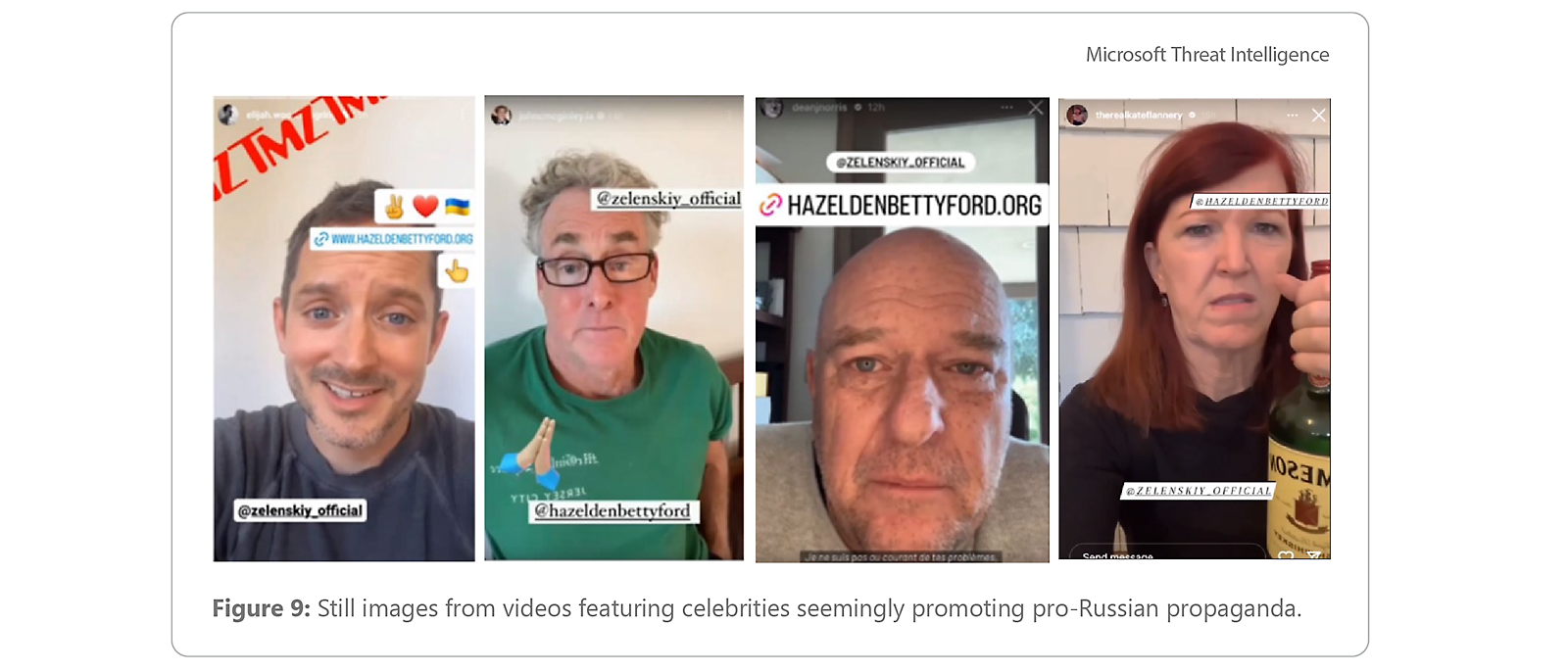
Russian fighters are moving to a new stage of static, trench warfare, according to Ukraine’s military chief, suggesting an even more protracted conflict.26 Kyiv will require a steady supply of weapons and popular support to continue resistance, and we are likely to see Russian cyber and influence operators intensify efforts to demoralize the Ukrainian population and degrade Kyiv’s external sources of military and financial assistance.
As winter approaches, we may again see military strikes aimed at power and water utilities in Ukraine, combined with destructive wiper attacks on those networks.27 CERT-UA Ukrainian cybersecurity authorities announced in September that Ukrainian energy networks were under sustained threat, and Microsoft Threat Intelligence observed artifacts of GRU threat activity on Ukrainian energy sector networks from August through October.28 Microsoft observed at least one destructive use of the Sdelete utility against a Ukrainian power company network in August.29
Outside of Ukraine, the US presidential election, and other major political contests in 2024 may afford malign influence actors an opportunity to put their video media and nascent AI skills to use to turn the political tide away from elected officials who champion support to Ukraine.30
Microsoft is working across multiple fronts to protect our customers in Ukraine and worldwide from these multi-faceted threats. Under our Secure Future Initiative, we are integrating advances in AI-driven cyber defense and secure software engineering, with efforts to fortify international norms to protect civilians from cyber threats. 31 We are also deploying resources along with a core set of principles to safeguard voters, candidates, campaigns, and election authorities worldwide, as more than 2 billion people prepare to engage in the democratic process over the next year.32
- [2]For technical information on the latest destructive attack methods in Ukraine see https://go.microsoft.com/fwlink/?linkid=2262377
- [8]Based on notifications issued between March 15, 2023, and October 23, 2023.
- [17]hxxps://cert[.gov[.]ua/article/5702579
- [24]ria[.]ru/20230817/zelenskiy-1890522044.html
- [25]tsargrad[.]tv/news/jelajdzha-vud-poprosil-zelenskogo-vylechitsja_829613; iz[.]ru/1574689/2023-09-15/aktrisa-iz-seriala-ofis-posovetovala-zelenskomu-otpravitsia-v-rekhab
- [29]For technical details https://go.microsoft.com/fwlink/?linkid=2262377




Follow Microsoft Security